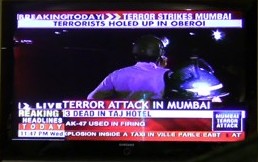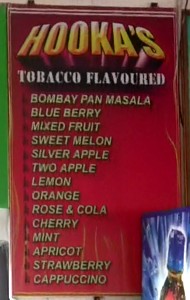I was in Mumbai (formerly Bombay, the name I find hard to discontinue using since I knew it as such for most of my life) during the month of November, on a vacation to visit family and friends. During this time, we visited our favourite haunts including the majestic Taj Hotel where we lunched at the Golden Dragon restaurant. I distinctly remember how impressed I was by the rich decor, classical ambiance and spaciousness of this century old structure. A few things were different I sensed, compared to my last visit seven years ago. There were more people for sure – milling in the lobby and at the entrance, with hundreds more just outside the periphery of the Taj, a spill over from the squeeze of visitors to the Gateway of India. Just outside the lobby, at the foot of the gleaming marble stairs, was a solitary narrow metal detector that visitors had to pass through before entering the hotel. It looked ugly, out of place in these surroundings, and hardly seemed effective. Once inside the hotel lobby, we tried to capture some video footage on our camcorder of the enormous room with the stunning chandelier and artefacts, but were politely asked to refrain from doing so, as we would be “offending guests”. (Had the staff been instructed to curb people from filming the interiors for security reasons, or was it truly because we might offend the sensibilities of guests and intrude their privacy, albeit in a fairly public place?)
 A few days later, we were enjoying an exquisite Indian buffet spread at a restaurant in another 5-star hotel a few kilometres away at an area popularly know as the Juhu beach. There was an outdoor wedding reception taking place on the beachfront. We saw headlines flash by on the restaurants big screen TV – there had been shootings at the main railway station in Mumbai, then at the Metro cinema in South Bombay. Within minutes, the channel was showing raw footage of the aftermath of gun attacks at Leopold’s Cafe. We thought it might be gang-related, but Leopold’s was hardly the kind of venue for assassinations of this sort. It was essentially a tourist hangout, and its clients didn’t didn’t seem to be sort who might be involved in trouble of this nature. Within few minutes we heard that the Taj was under attack, Continue reading
A few days later, we were enjoying an exquisite Indian buffet spread at a restaurant in another 5-star hotel a few kilometres away at an area popularly know as the Juhu beach. There was an outdoor wedding reception taking place on the beachfront. We saw headlines flash by on the restaurants big screen TV – there had been shootings at the main railway station in Mumbai, then at the Metro cinema in South Bombay. Within minutes, the channel was showing raw footage of the aftermath of gun attacks at Leopold’s Cafe. We thought it might be gang-related, but Leopold’s was hardly the kind of venue for assassinations of this sort. It was essentially a tourist hangout, and its clients didn’t didn’t seem to be sort who might be involved in trouble of this nature. Within few minutes we heard that the Taj was under attack, Continue reading
